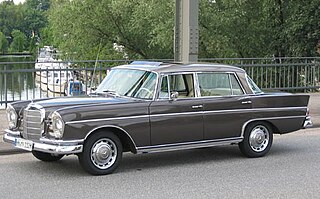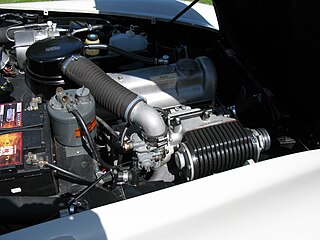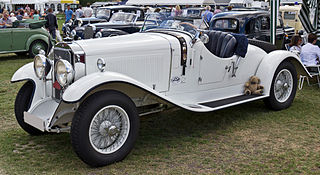
The Mercedes-Benz S-Class, formerly known as Sonderklasse, is a series of full-sized luxury sedans, limousines and armored sedans produced by the German automaker Mercedes-Benz. The S-Class is the designation for top-of-the-line Mercedes-Benz models and was officially introduced in 1972 with the W116, and has remained in use ever since. The S-Class is one of the flagship vehicles for Mercedes-Benz.

The Mercedes-Benz W128 is a 6-cylinder luxury car produced by Mercedes-Benz from 1958 to 1960 and marketed as the Mercedes-Benz 220 SE. It was available in sedan, coupé, or cabriolet body styles, and it was the last new model of the "Ponton" range which had design and styling roots beginning in 1953 with the Mercedes-Benz 180 sedan. It was largely identical to its 220 S predecessor, except for having petrol injection, 'Einspritzung' in German, reflected in the additional E in its 220 SE designation.

The W110 was Mercedes-Benz's entry-level line of midsize automobiles in the mid-1960s. One of Mercedes' range of "Fintail" models, the W110 initially was available with either a 1.9 L M121 gasoline or 2.0 L OM621 diesel inline-four. It was introduced with the 190c and 190Dc sedans in April 1961, replacing the W120 180c/180Dc and W121 190b/190Db.

The Mercedes-Benz W111 was a chassis code given to a range of Mercedes-Benz vehicles produced between 1959 and 1971, including four-door saloons (1959–1968) and two-door coupés and cabriolets (1961–1971). Their bodywork featured distinctive tailfins that gave the models their Heckflosse nickname — German for "fintail".

The Mercedes-Benz "Ponton" series are a range of sedans / saloon car models from Daimler-Benz, introduced starting in 1953, and subsequently nicknamed 'Ponton', referring to its ponton styling, a prominent styling trend that unified the previously articulated hood, body, fenders and runnings boards into a singular, often slab-sided envelope. At the time, Mercedes itself did not refer to any of its cars using the nickname.

The Mercedes-Benz W112 is a luxury automobile produced by Mercedes-Benz from 1961 to 1967. Marketed as the 300SE, it was available as a coupé, convertible, sedan, and stretched sedan (Lang), all generally similar in appearance to the corresponding Mercedes-Benz W111.

The Mercedes-Benz W136 was Mercedes-Benz's main line of inline-four cylinder motorcars from the mid-1930s into the 1950s. The model 170 V made its public debut as successor to the W15 Typ 170 in February 1936. Between 1936 and 1939 it was Mercedes' top selling model.
The Mercedes-Benz MB100 is a light commercial cabover van (M) made by Mercedes-Benz España S.A. from 1981 to 1996 at their Vitoria-Gasteiz factory in northern Spain. The third generation model was manufactured by SsangYong alongside the rebadged SsangYong version from 1995 to December 2003 in South Korea, with another rebadged variant manufactured by Maxus of SAIC Motor from 2009 to 2014 in China.

The Mercedes-Benz W180 is an inline 6-cylinder saloon, coupé, and convertible made from 1954 until 1959. The models associated with the W180 chassis code were the 220 a and 220 S.

The Mercedes-Benz 190 SL (W121) is a two-door luxury roadster produced by Mercedes-Benz between May 1955 and February 1963. Internally referred to as W121, it was first shown in prototype at the 1954 New York Auto Show, and was available with an optional removable hardtop.

The Mercedes-Benz Vito is a mid-sized light commercial vehicle (LCV) produced by Mercedes-Benz, available as a panel van, chassis cab, or multi-purpose vehicle (MPV), carrying cargo or up to eight passengers. In the Mercedes-Benz van lineup, it is positioned between the larger Sprinter and the smaller Citan.

From 1931 to 1939, Daimler-Benz AG produced three cars with rear engine as well as a few prototypes. The production numbers remained quite low for each of these models, especially compared to the production of classical front-engine Mercedes cars.

The Mercedes-Benz W105 is the internal designation for a four-door executive car, manufactured by Daimler-Benz from 1956 to 1959, and marketed as the Mercedes-Benz Typ(e) 219. The W105 was nicknamed Ponton, along with its Mercedes model siblings, from its introduction, because it employed ponton, or pontoon styling, a defining post-war car design innovation that unified a car's previously articulated bonnet, wings, body and running boards into a singular, slab-sided envelope.

The Mercedes-Benz M121 engine was a 1.9 liter single overhead camshaft inline four-cylinder engine introduced by Mercedes in 1955 and used in various model lines during the 1950s and 1960s. Originally rated at 56 kW at 5500 rpm, it replaced the 1.8 liter M136 introduced in 1935, offering improved performance over the M136's side camshaft design.

The Mercedes-Benz 170 S is a luxury car which was produced by Mercedes-Benz from 1949 until 1955 in various gasoline and diesel powered forms. It was initially offered with a 1.8 liter version of the 1.7 liter inline-four cylinder M136 engine used in the slightly smaller production type 170 V. It was the first Mercedes-Benz to carry in its name the suffix “S” (for Sonder modell denoting a superior level of comfort and quality. As such, its intended market was successful business owners and company directors.

The Mercedes-Benz OM636 is a diesel engine that was produced by Daimler-Benz from 1948 until 1990. Being the successor to the OM138, the OM636 has been used both as a passenger car engine and as an industrial engine. It saw its first use in the Boehringer Unimog in 1948, prior to its official introduction in the 1949 Mercedes-Benz W136. Throughout the 1950s, the OM636 was widely used in the Mercedes-Benz W120. In 1958, it was succeeded by the OM621 passenger car engine. However, after the introduction of the OM621, the OM636 was kept in production for industrial vehicles such as small lorries, boats, and combine harvesters, until 1990.

The Mercedes-Benz W08 was a large luxury car produced by Daimler-Benz. It was introduced in Autumn 1928, as Mercedes-Benz's first eight-cylinder passenger car. Also known by various “type numbers”, it remained in production with various modifications and upgrades until the later summer of 1939, the longest lived Mercedes-Benz model of the 1920s and 1930s.

Mercedes-Benz W202 is the internal designation for a compact sedan/saloon manufactured and marketed by Mercedes-Benz between 1992–2001, as the first generation of the C-Class, now in its fifth generation. Replacing the 190 series/W201 in June 1993, the C-Class sedan was Mercedes' entry-level model until 1997, when the company launched the A-Class. Production reached 1,847,382 over model years 1994–2000.

The Mercedes-Benz W205 is the fourth generation of the Mercedes-Benz C-Class which was produced by Daimler AG between 2014 and 2021. The W205 C-Class was preceded by the W204 C-Class and superseded by the W206 C-Class. The fourth-generation C-Class was available in sedan (W205), station wagon/estate (S205), coupe (C205), cabriolet (A205) and long-wheelbase sedan (V205) body styles.
The OM621 is an inline-four diesel engine produced by Mercedes-Benz, from 1956 to 1968. It was succeeded by the OM615 engine.






















